Where my first post on Christian Jerusalem covered Christian sites around the Old City (Mt Zion, Mount of Olives) this one gets within the Old City walls and covers the site of a miracle and the ‘Via Dolorosa’- the route Jesus is believed to have walked, carrying his cross, from his judgement to his crucifixion.
Over the centuries there have been several versions of Jesus’ route to Calvary – which at the time lay just outside the walls of the small city, but is now encompassed within it, with the Church of the Holy Sepulchre built over it. The first reports of a pilgrimage here was from the Byzantine times when pilgrims on Easter Thursday started at the top of the Mount of Olives, walked down into Gethsemene then up and into the city through the Lion’s Gate and then followed roughly the route that exists today.
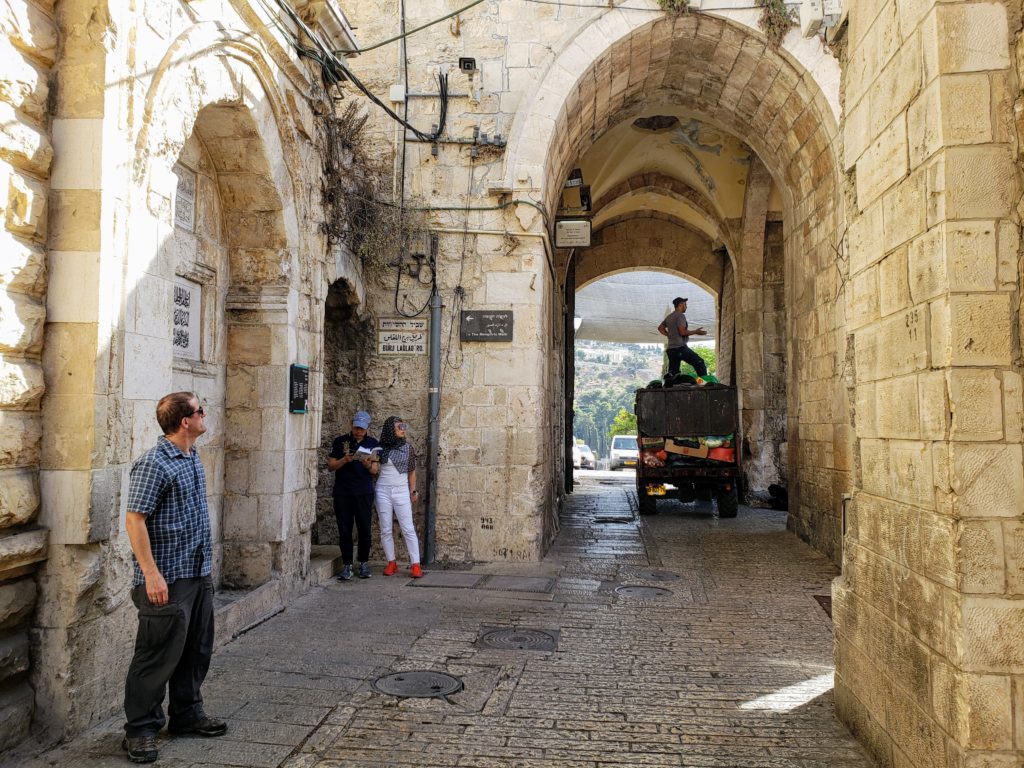
We started at the Lion’s Gate and took in a couple of interesting sites along the way before the official ‘Way of the Cross’ began. About 50 metres from the Lions Gate, we saw a sign for the birth place of the Virgin Mary. We went down underneath the ground to a little cave the Greek Orthodox Christians claim is her birthplace and saw the small chapel above it.
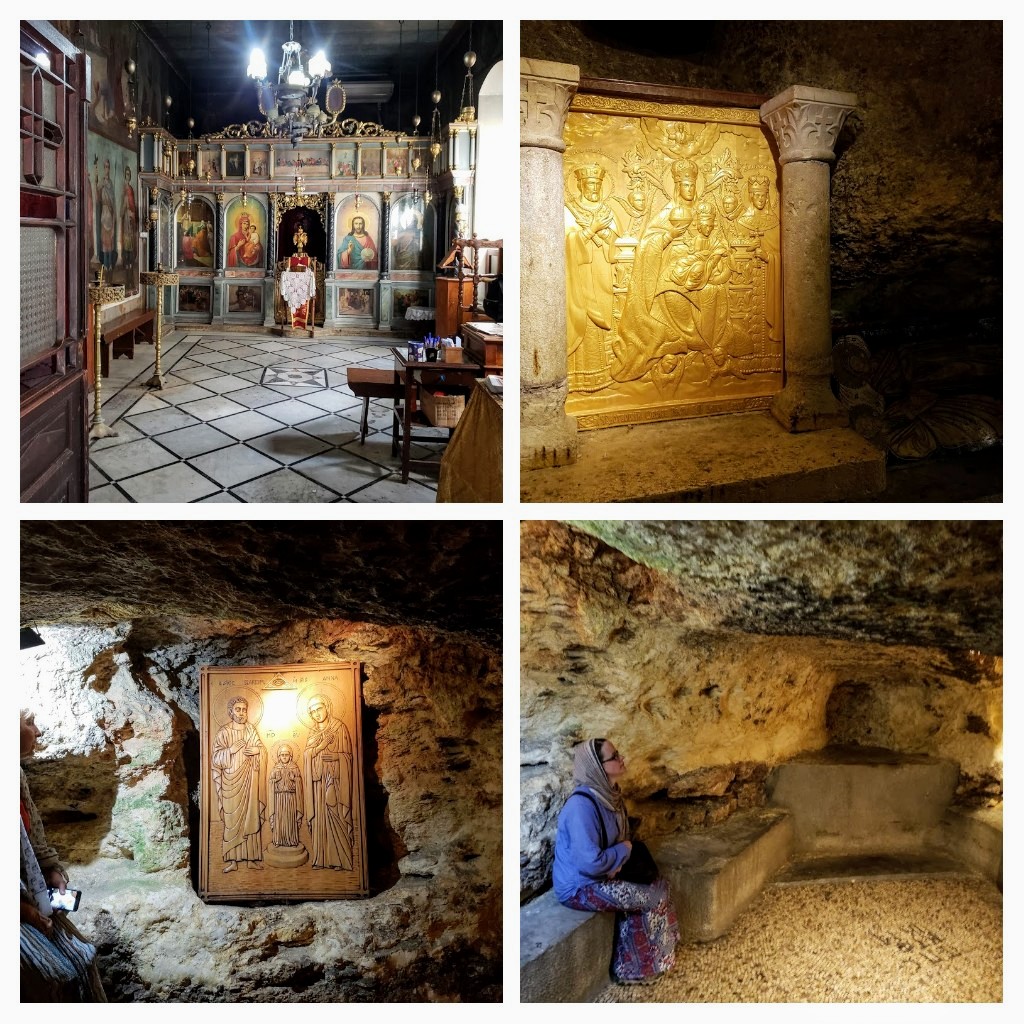
A few doors down is Saint Anne’s – a much bigger and more popular Church which since the 6th century has claimed to be the birthplace of Mary and dedicated to her mother – Anne. The Saint Anne’s site is worth a visit as not only is the Church the best preserved Crusader era church in Jerusalem, it has amazing acoustics and beside it a significant archaeological site.
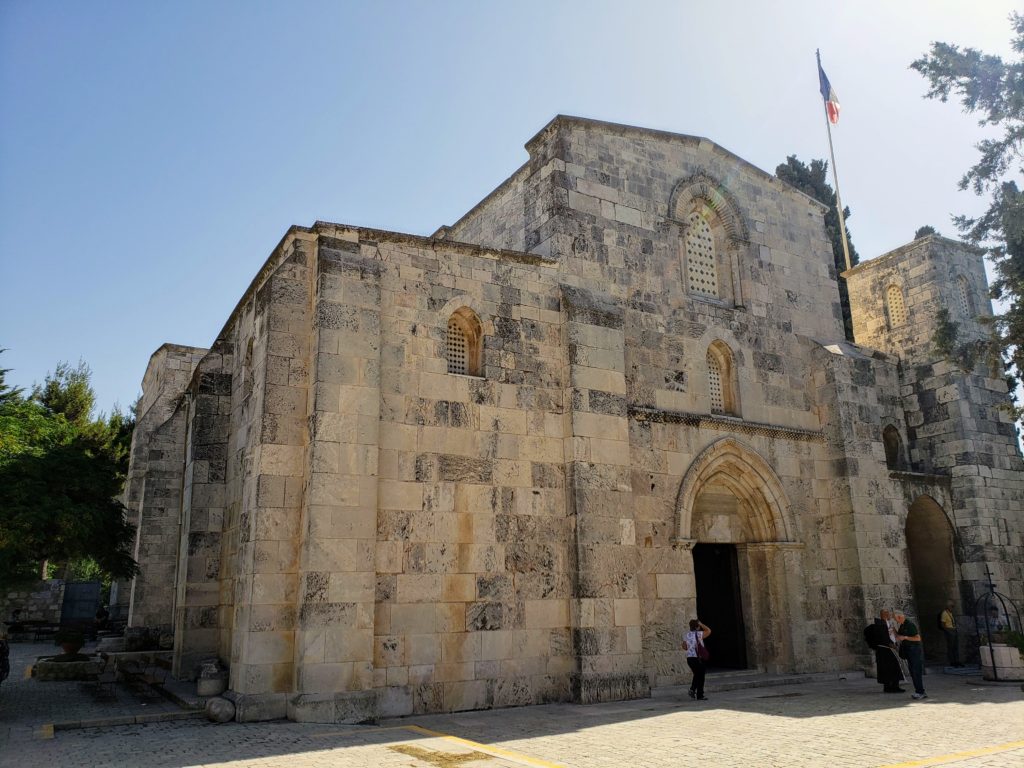
Built in 1140 the current church was built on the place, according to tradition, where Mary’s parents Anne and Joachim had their house. My Catholic grandmother on my father’s side was named Anne – I thought of her when here – hadn’t clicked that she was perhaps named after Mary’s mother until this visit.
Luckily Saint Anne’s was not ruined in Saladin’s conquest of Jerusalem in 1192- instead it was transformed into a school for Islamic Law. You can still see the Arabic inscription above the door which mentions Saladin’s name. Later under Ottomon rule the church was pretty much abandoned until the Ottomons rewarded the French (for their support in the Crimean War) with it. The French started restoring it and began the acheological excavations beside it in the late 1850s. In 1878 it was entrusted to the Missionaries of Africa who have continued to look after it and complete excavations right up until the 1990s.
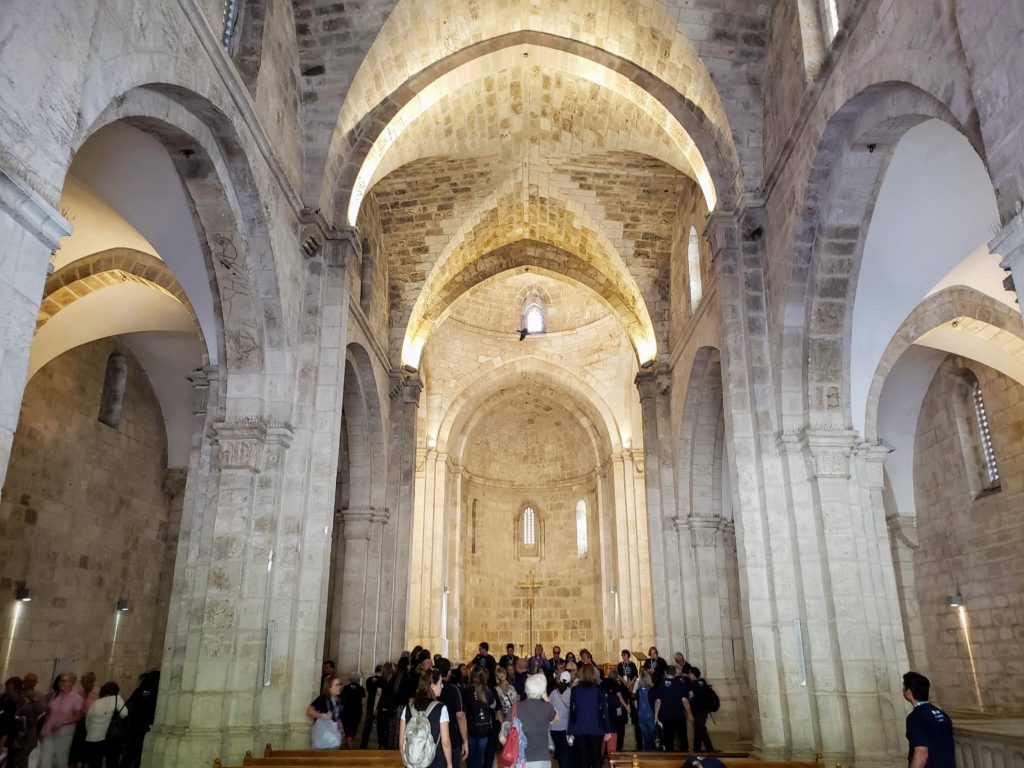
The Church is really simple inside with not a lot to look at – the cave underneath is the supposed remains of the house of Anne and Joachim, and the Virgin Mary’s birthplace. There’s a small altar and some paintings there. The church is a bit unusual in that its design isn’t symmetrical – opposite columns don’t match, windows are all different sizes and buttresses differ in thickness and height. What truly is amazing here is the acoustics. I heard a couple of tour groups have a sing and the sound was amazing! So loud.
Right beside the Church is the archaeological site of Bethseda – familiar to some of you perhaps from the gospel story that mentions it (John 5: 1-9). During Herod’s reign two large pools were constructed here to collect rain water. There were five porticos around them and a dam that separated them. Pilgrims headed for the Southern Pool for a ritual bath or to seek relief from sickness. The bible story goes that a man who’d been ill for 38 years was lying by the pool hoping to be the first one in the water after it was disturbed by an angel. Someone always beat him to it though. Jesus saw him and asked him if he wanted to be well – which of course he did so Jesus told him to just get up and walk around. He was cured at once. To commemorate this healing a large church was built here in the 5th century – only a few bases from the pillars remain today as the whole complex was damaged in 614 when the Persians invaded.
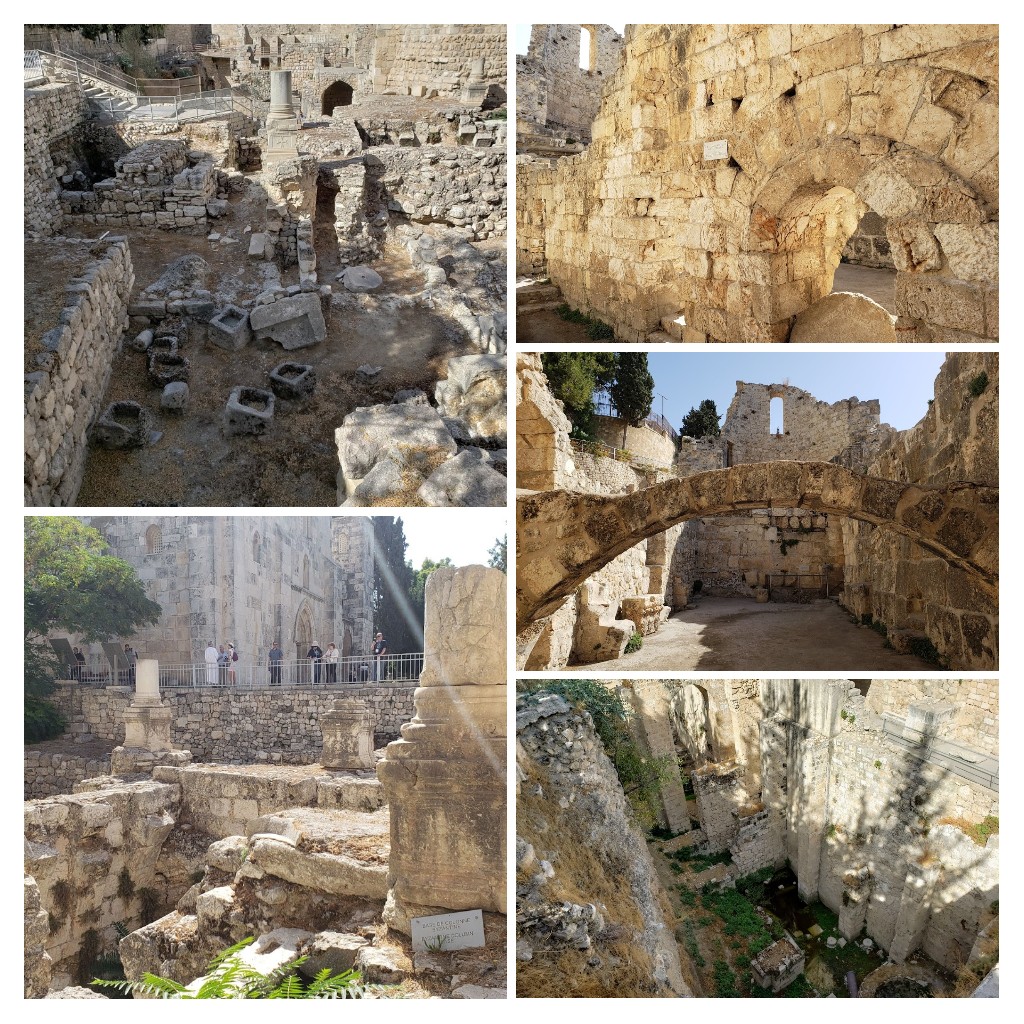
Leaving Saint Anne’s we head to Stations 1 & 2 which mark the point where Jesus was condemned by Pontius Pilate and given his cross. Station 1 now lies within a Muslim school. Not strange given most of the Via Dolorosa is in the Muslim Quarter of the Old City. Near station 1 are a couple of churches marking the events: the ‘Church of the Flagellation’ and ‘Church of the Condemnation and Imposition of the Cross’.
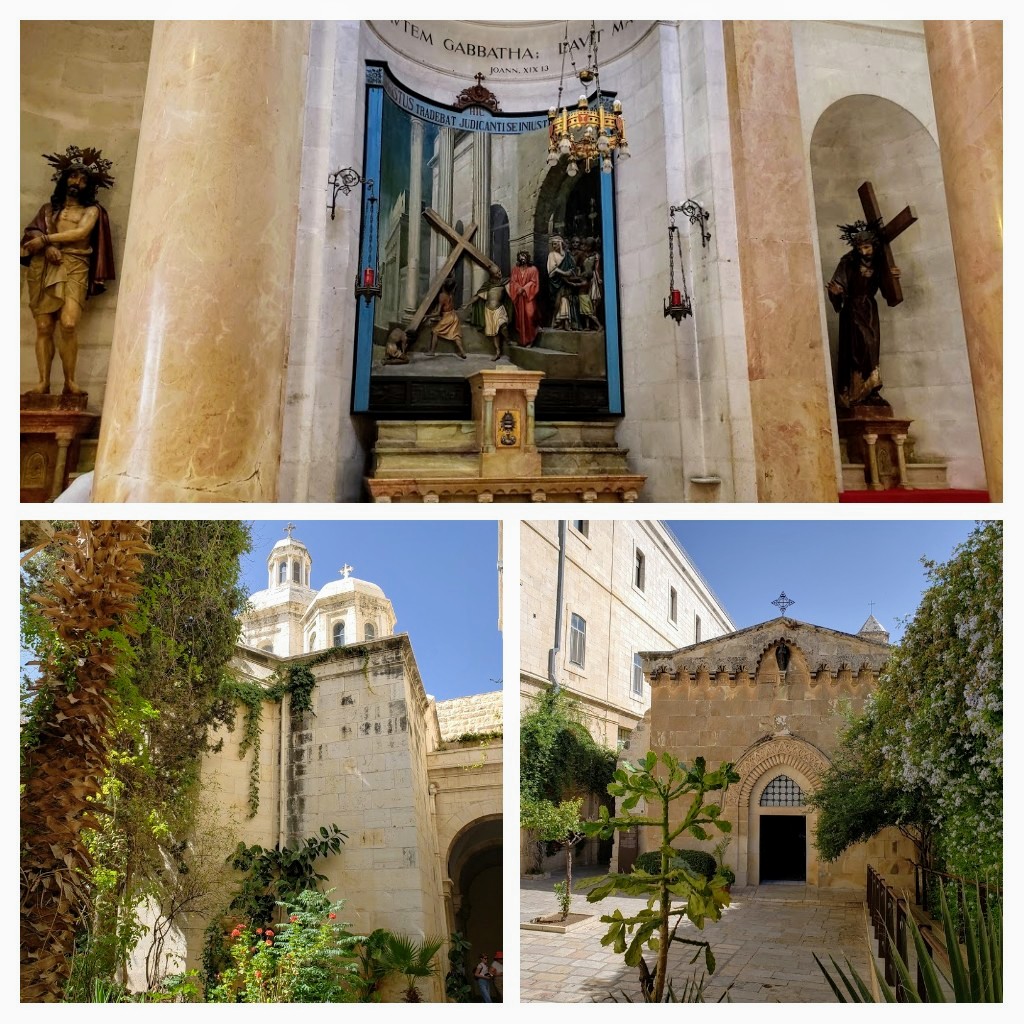
The Ecce Homo arch is near where Pilate gave Jesus the crown of thorns and a purple robe and where he pointed out Jesus to the crowd saying ‘behold the man’ which in latin is ‘Ecce Homo.’
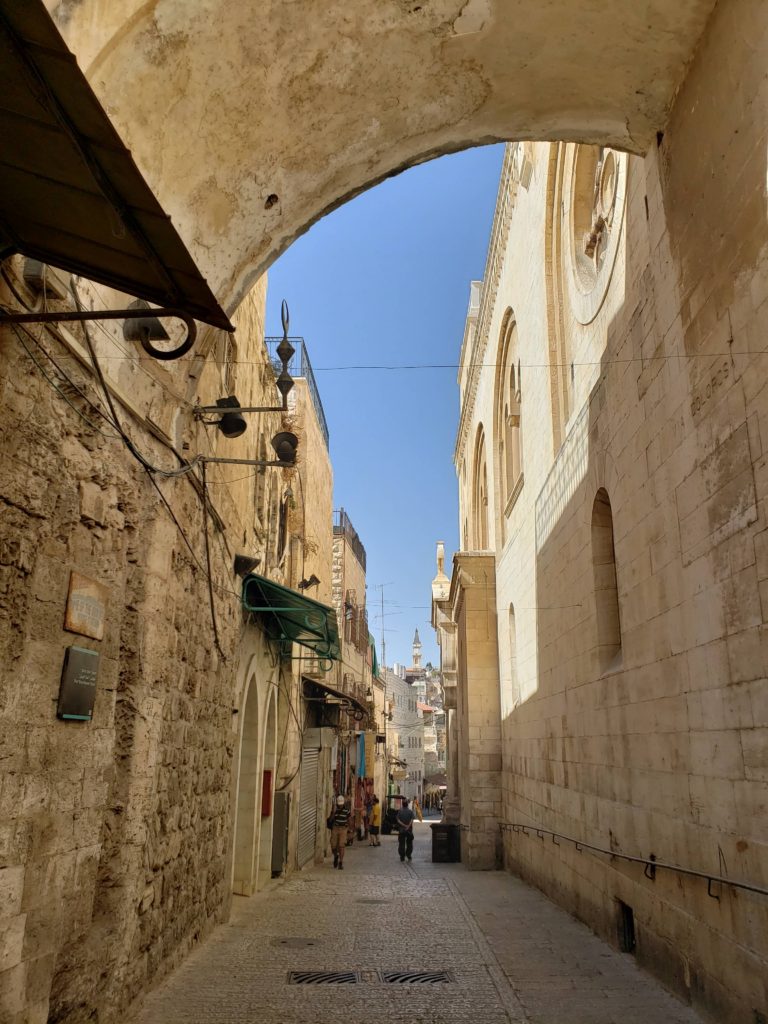
Not far from the arch was what the Greek Orthodox consider to be the prison of Jesus. You ask the Armenians or the Franciscans and they’ll tell you the prison is elsewhere but anywho… we saw this and took a look inside.
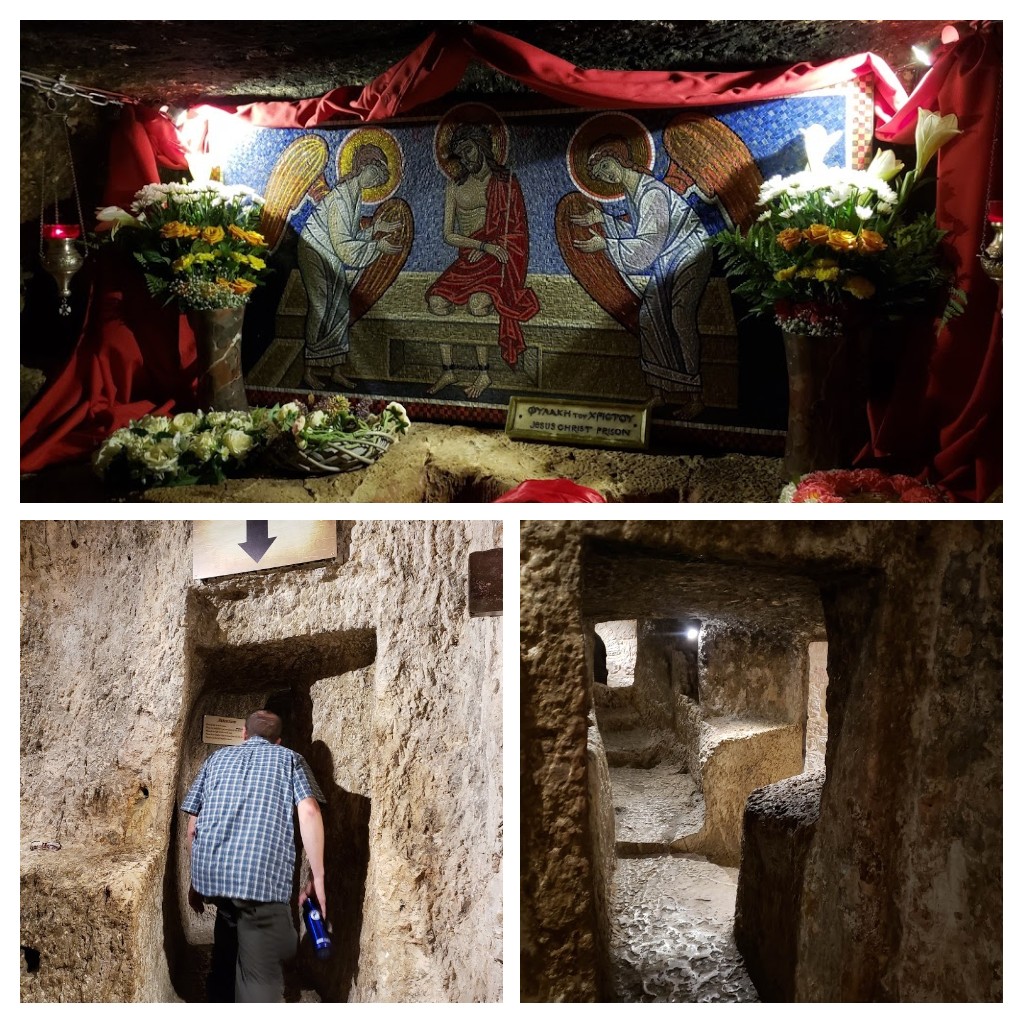
Many of the stations were just numbers on a wall (easy to miss) supposedly the place where Jesus did something or other. With the heat and the people around (and having already had a good few hours walking the city before getting here) we weren’t terribly interested in all the stations -most of which were not remembering events that are recorded anywhere – many just ‘tradition’. Station 3 Jesus supposedly falls here, Station 4 Jesus sees his mother Mary in the crowd, Station 5 Jesus is helped by Simon the Cyrene (this is recorded in Matthew, Mark and Luke), Station 6 Jesus brow is wiped by Veronica’s cloth – leaving an imprint of his face in it (!), Station 7 Jesus falls, Station 8 He talks to the women of Jerusalem (recorded in Luke), Station 9 he falls again.
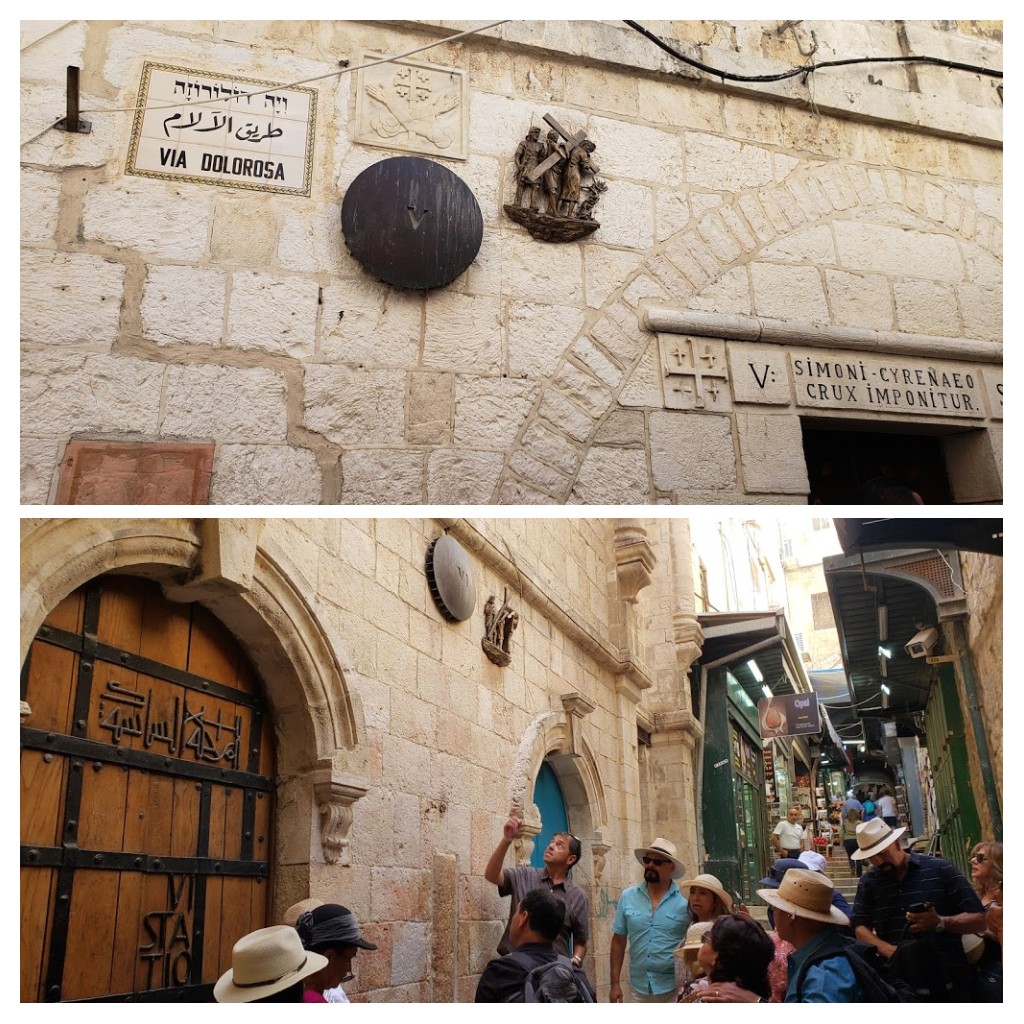
Stations 10-14 are all in the Church of the Holy Sepulchre, built over Calvary (Golgotha) where Jesus was crucified. Our first visit to the large church was during an afternoon and it was packed. It took a long time to just get through the door and up the stairs to the site where Jesus was nailed to the cross. Any sense of this being a holy place was completely undone by the way we had to shuffle around with the masses and wait in lines to get to the next part of the church. It was crazy. After this experience we decided to head back early in the morning on a different day.
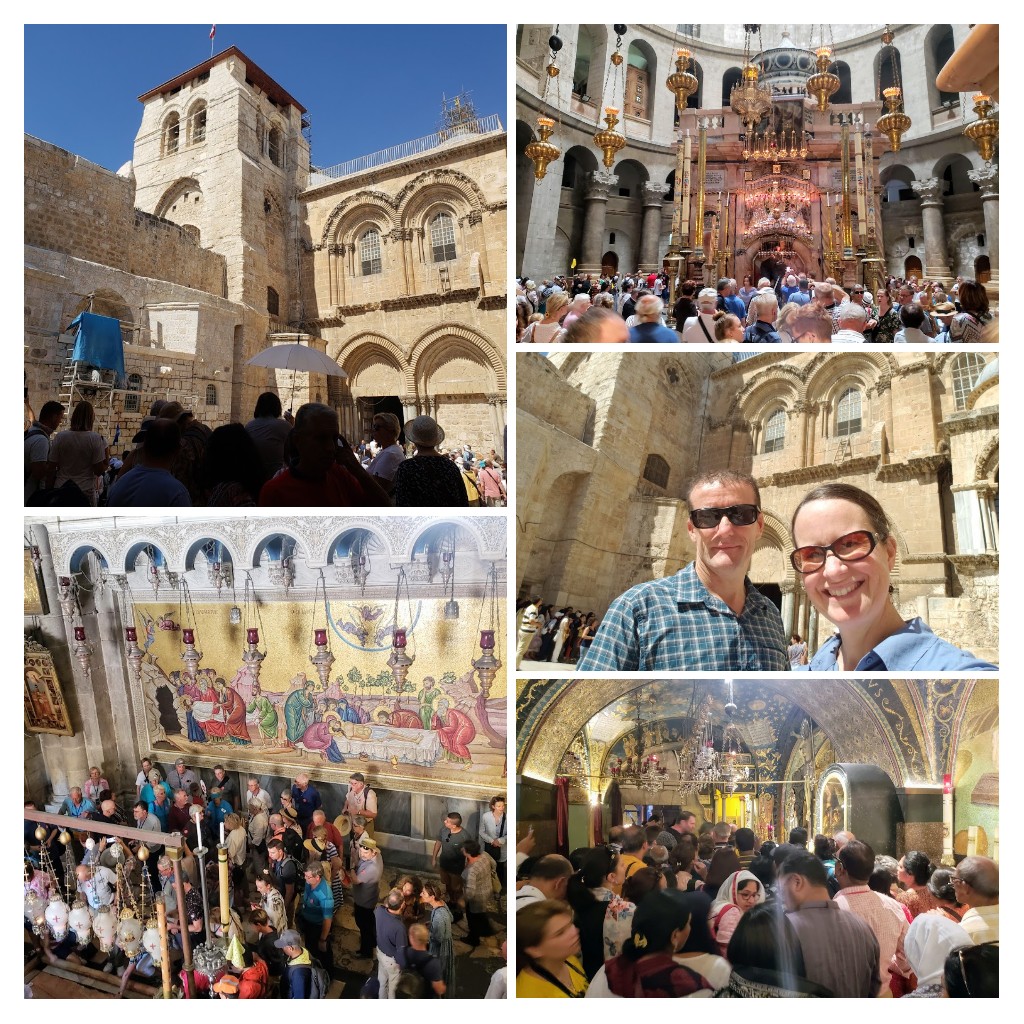
Station 10 of the Way of the Cross is the courtyard outside the church where the convicts were gathered and crowds could see their humiliation. Jesus was stripped of his clothes here.
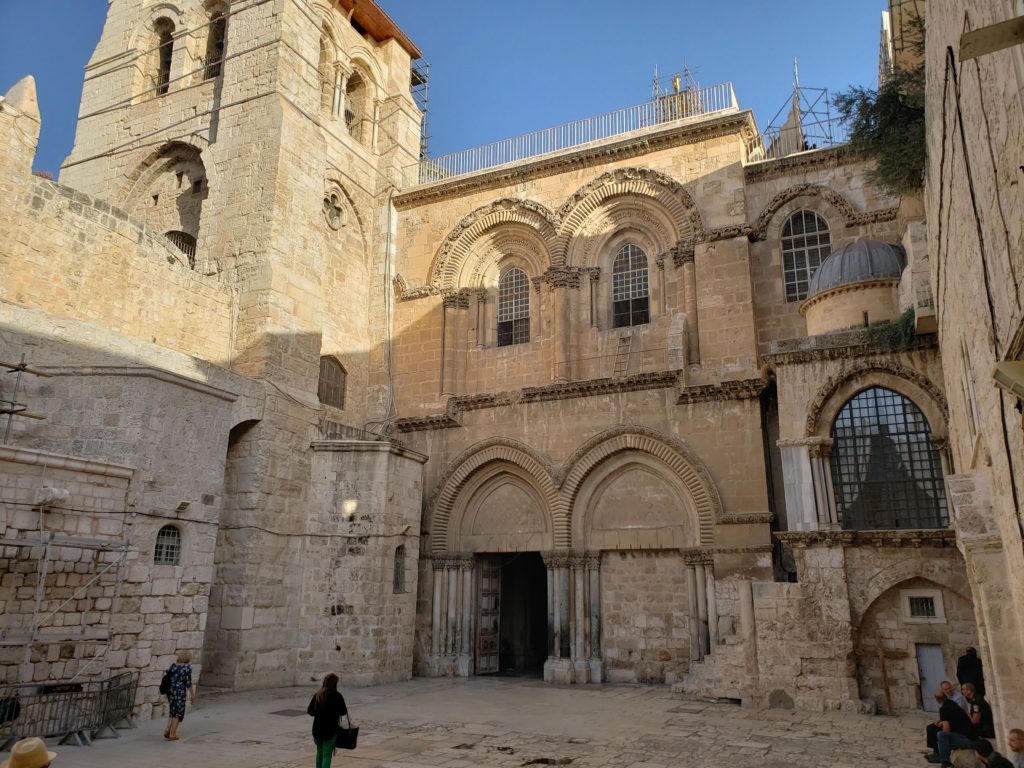
You might think for such an important place this Church would be really grand – but it is very humble from the outside, not even that recognisable as a church. It is squished in among other buildings with a mosque opposite it. The photo above shows the only view of the church from the street. From viewpoints around the city you can see the dome which is above the part of the church that is Jesus tomb. See the video below to see the church from above and get a feel for how squished in this area of the Old City is.
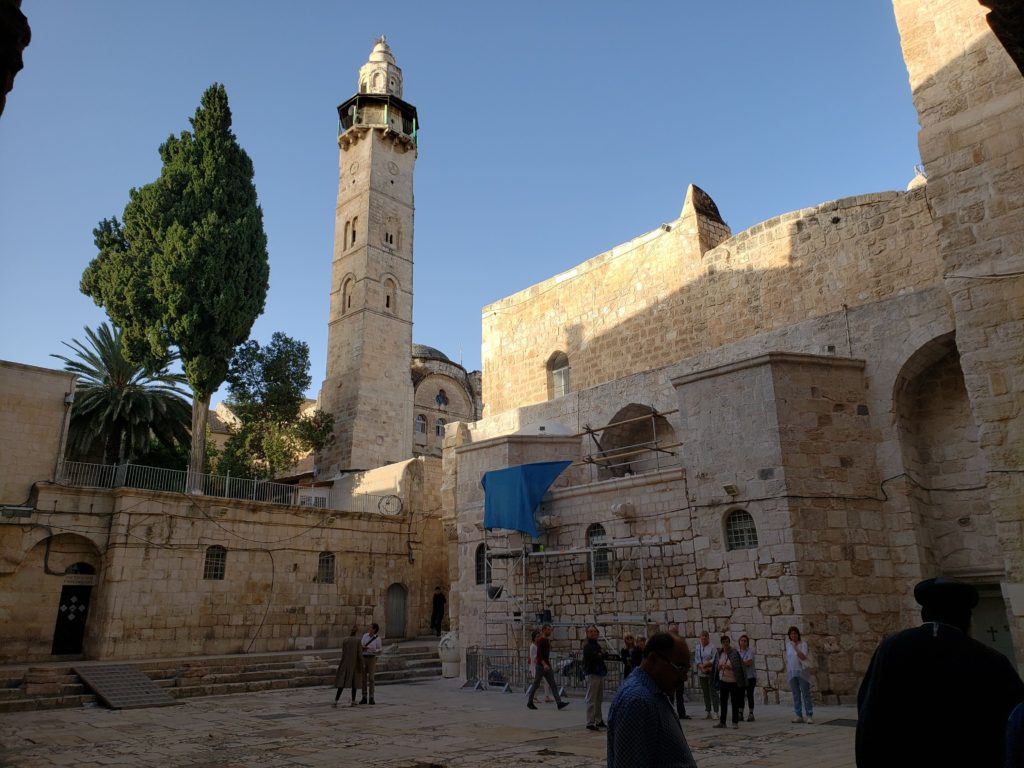
So on entering the Church you need to go upstairs to get to what was the hill of Calvary or in aramaic Golgotha. Here you’ll find Station 11 where Jesus was nailed to the cross – it’s a Roman Catholic chapel. Beside it is station 12 the lavish Greek Orthodox chapel literally over the rock where Jesus was crucified. The rock is visible on either side of the altar and there is a place where you can put your hand through something to touch the rock. Clearly a spiritual experience for some.

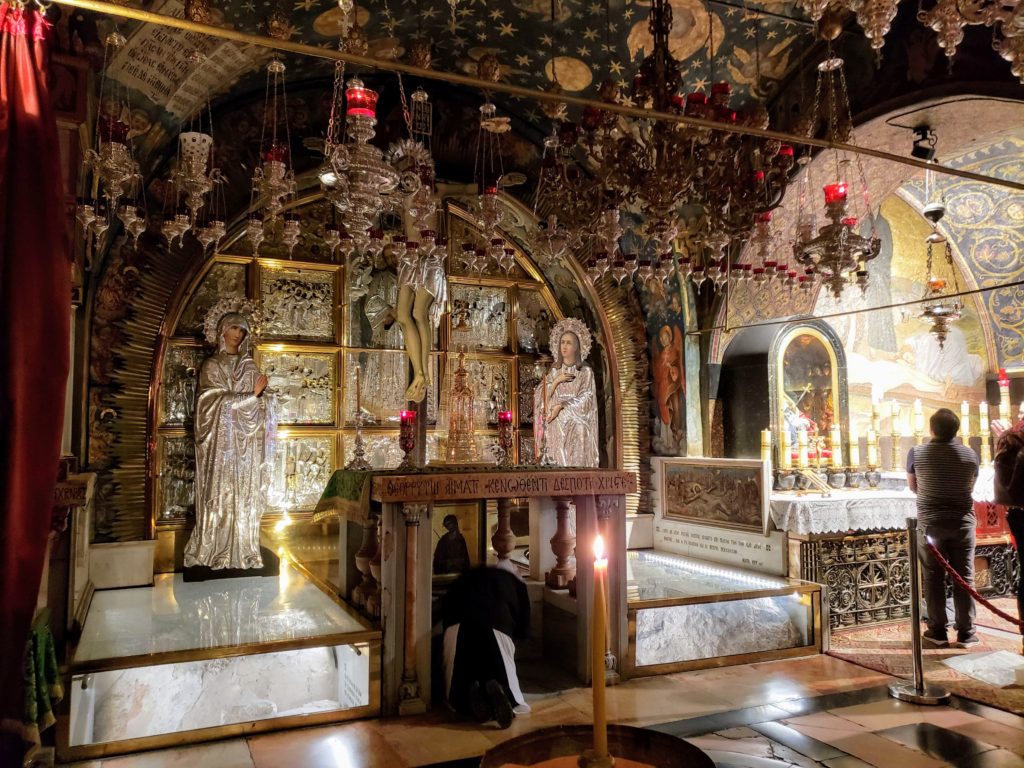
Station 13 is supposedly the stone slab Jesus body was laid on when he was taken down off the cross and prepared for burial. People were crowding in to touch this and say a prayer. I followed suit when we came on our second trip early in the morning with almost noone around but did not feel anything special. Christian holy sites just don’t seem to do it for me. I’ve felt closer to God when skiing or in some of the mosques in Iran. The large mosaic mural on the wall behind the rock was beautiful and worthy of some contemplation.
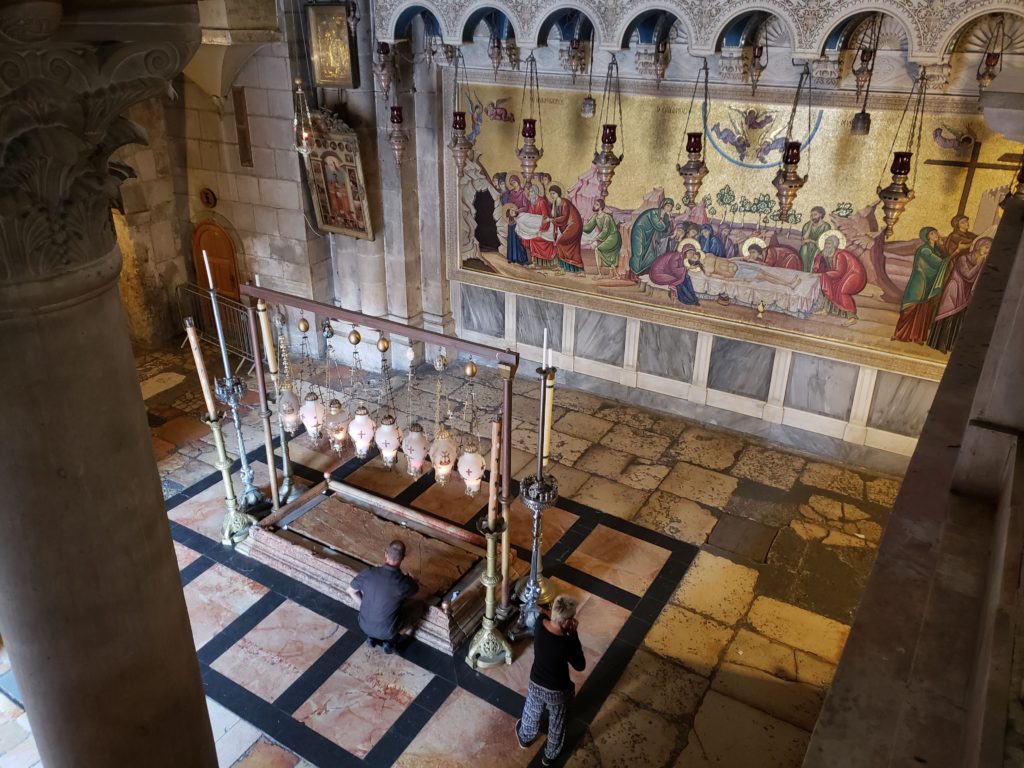
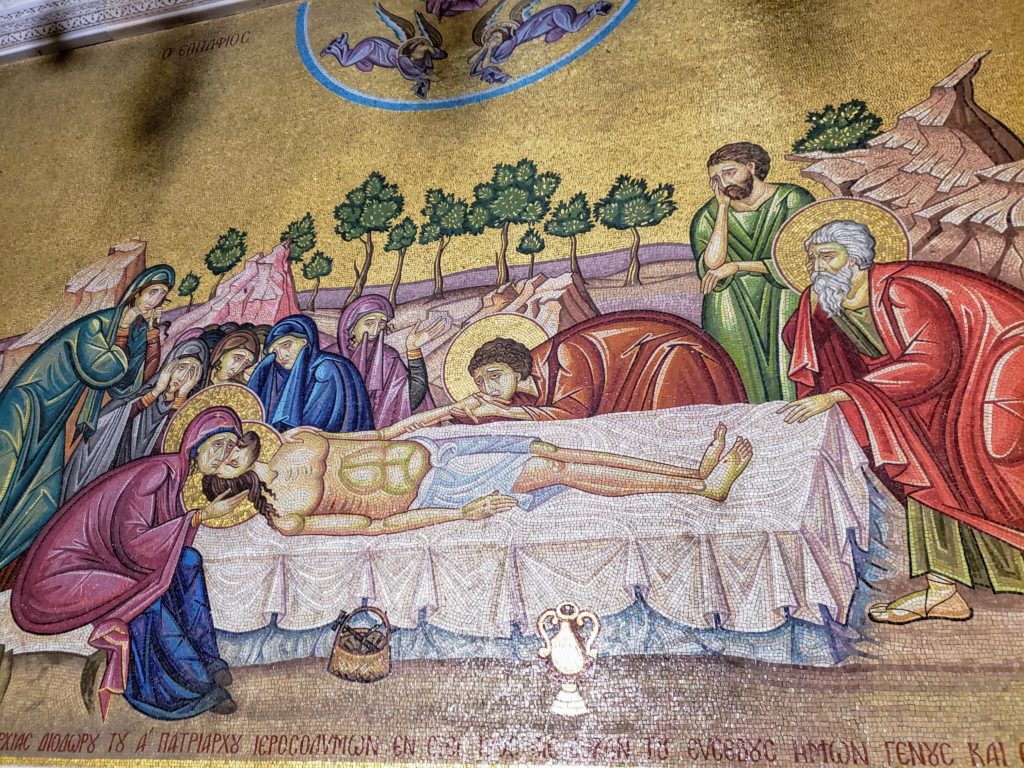
Station 14 is Jesus tomb – empty of course! The line to get in was so long – it would have been many hours wait when we first visited the Church. Timing our second visit before 8am meant we only had to wait about 20 minutes and we were serenaded by some form of orthodox service happening nearby. The tomb is in the far west side of the church in the Rotunda, under the big grey dome you could see on the video above. Below is the view as we waited in line to enter the tomb. Once inside the small space we got quickly hurried on and the line waiting was stopped as they made preparations for a Bishop to enter.
Interestingly the Church of the Holy Sepulchre is not any particular denomination, rather several branches of Christianity have custodianship over it, namely the Greek Orthodox, the Armenian Apostolic Chruch and the Roman Catholics. (In the 19th century lesser responsibilities were also had by the Coptic Orthodox, Ethiopian Orthodox and Syrian Orthodox churches). The three main denominations all have rights to the inside of the tomb and conduct their liturgy/ Mass here daily… perhaps that’s what the Bishop had arrived to do.
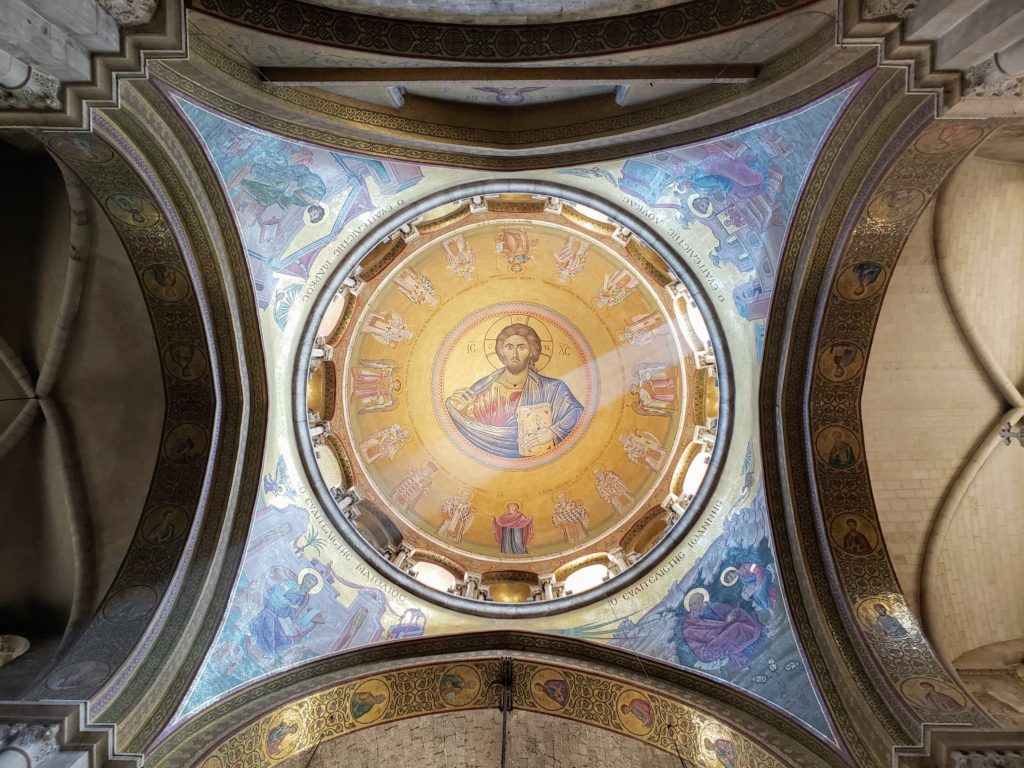
As I round off this post, it is worth mentioning that the fourth quarter of the Old City (after the Jewish, Christian and Muslim quarters) is the Armenian Quarter which is also a Christian quarter. When walking through this the quiestest of the quarters we popped in to see the 12th century Armenian Cathedral of Saint James but it was closed. The courtyard area outside was nice though.
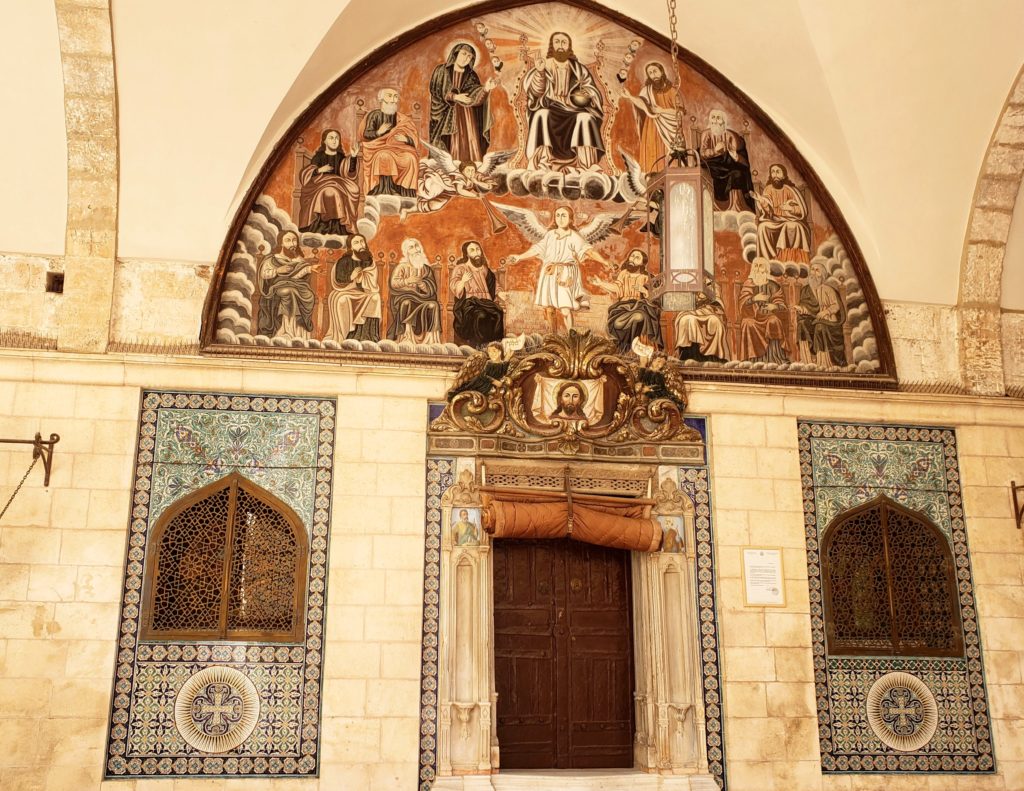
Ok that’s it for Christian Jerusalem. By no means have I covered all the Christian sites and churches but the most important things I think we managed to see and write about here. Muslim Jerusalem is next…